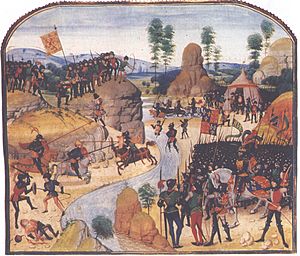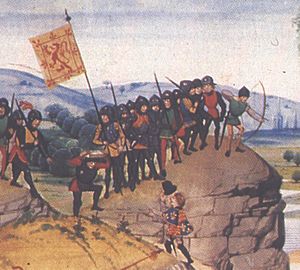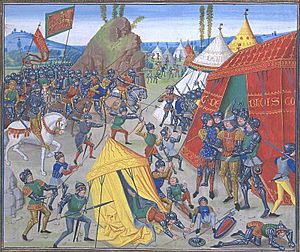Weardale campaign facts for kids
Quick facts for kids Weardale campaign |
|||||||
|---|---|---|---|---|---|---|---|
| Part of the First War of Scottish Independence | |||||||
 Battle of Stanhope Park |
|||||||
|
|||||||
| Belligerents | |||||||
| Scotland | England | ||||||
| Commanders and leaders | |||||||
| James, Lord of Douglas Thomas, Earl of Moray Donald, Earl of Mar |
Edward III Roger Mortimer |
||||||
| Strength | |||||||
| 10,000 | Unknown | ||||||
| Casualties and losses | |||||||
| Unknown | Unknown | ||||||
The Weardale campaign was a military event that happened in July and August 1327. It was part of the First War of Scottish Independence, a long conflict between England and Scotland. This campaign took place in Weardale, a valley in England. A Scottish army, led by James, Lord of Douglas, and the earls of Moray and Mar, faced an English army. The English army was commanded by Roger, Lord Mortimer, and the young king, Edward III, was also with them.
In 1326, the English king Edward II was removed from power by a rebellion. This rebellion was led by his wife, Isabella, and her close friend, Mortimer. England had been fighting Scotland for 30 years. The Scots used this time of trouble in England to launch big raids into English lands. Isabella and Mortimer wanted to show they were strong leaders. They thought stopping the Scots would make people trust them more. So, they gathered a large army to fight the Scots. In July 1327, this army left York. Their goal was to trap the Scots and force them into a battle. After two weeks of bad weather and not enough food, the English found the Scots. The Scots had purposely shown their location.
The Scottish army took a very strong position north of the River Wear. It was almost impossible to attack them there. The English decided not to attack, and the Scots refused to come out and fight in the open. After three days, the Scots moved quietly during the night to an even stronger spot. The English followed them. That same night, a group of Scottish soldiers crossed the river. They successfully raided the English camp, even reaching the king's tent. The English believed they had the Scots surrounded and that the Scots would soon run out of food. But on the night of August 6, the Scottish army secretly left. They marched all the way back to Scotland. This campaign was very expensive for the English. Isabella and Mortimer had to make peace with the Scots. In 1328, they signed the Treaty of Edinburgh–Northampton. This treaty officially recognized Scotland as an independent country.
Contents
Why the Campaign Happened
The First War of Scottish Independence started in March 1296. That's when Edward I of England (who ruled from 1272 to 1307) attacked and took the Scottish town of Berwick. This was the start of his invasion of Scotland. By 1323, the English, now led by Edward II, had been completely pushed out of Scotland. Robert Bruce was firmly on the Scottish throne. He had also led several big raids deep into England. In May 1323, a peace agreement for 13 years was made. But Scottish raids continued, and English ships still attacked Scottish ships.
By February 1326, it was clear that Edward II's wife, Isabella, and Roger Mortimer were leading a group against King Edward II. They were living in Paris and had French support. In April, the Scots made a military agreement with the French. In September, Isabella, Mortimer, and the king's son, 13-year-old Prince Edward, landed in England. King Edward II quickly lost his power. Isabella's group took control of the government, and Edward II was captured in November.
Edward II gave up his throne in January 1327. This happened because he was threatened that his son would not become king. A few days later, Prince Edward was crowned as Edward III. Everyone knew that his mother and Mortimer planned for the young Edward to be their puppet king. With Edward II gone, Isabella and Mortimer needed to prove they had the right to rule. The Scots saw this as a chance. While Edward III was being crowned, a Scottish force was attacking Norham Castle, an English castle on the border. Edward II had refused to accept Robert Bruce as king of Scotland. The Scottish raids aimed to pressure the English to recognize Bruce as their king.
Stopping the damaging Scottish raids by winning a battle would help Isabella and Mortimer gain support. For Robert Bruce, showing that the English could not stop the raids would put him in a strong position to demand peace. Because of all these pressures, the peace agreement broke down. Both sides got ready for a full war.
Getting Ready for Battle
Robert Bruce was sick during 1327. But this did not stop the Scots from putting pressure on England. On June 15, a large Scottish force crossed the border to raid. In July, a Scottish army entered England again. Reports say it had 10,000 mounted men. It was led by Donald, Earl of Mar, Thomas, Earl of Moray, and James, Lord of Douglas. This army carried very few supplies or baggage wagons. Instead, they spread out over a wide area to find food. This was unusual for armies at that time, which usually stayed close together. This way of moving gave the Scots a lot of freedom to move around. Their spread-out formation, which could cover over 70 miles, also made it hard for the English to know how many Scots there were, where they were going, or even their main direction. They robbed and burned their way south. By July 5, they had reached Appleby.
The English had gathered an army at York. It was stronger and better-equipped than the Scottish army. This army included 780 soldiers from Hainault, who were paid fighters. While gathering, the Hainault soldiers fought with the English foot soldiers. They had a running battle through York, and both sides lost many men. The English placed a large group of Welsh troops at Carlisle. They also had a strong group of soldiers at Newcastle upon Tyne. The English thought these forces on their sides, plus the difficult land, would make it hard for the Scots to retreat. This would allow the main English army to force the Scots to fight. The English army at York left on July 1. They reached Durham on July 15. Edward III was with the army as the king, but Mortimer was the real commander. Isabella stayed in York. From Durham, the English saw smoke from burning farms. This showed that at least some of the Scots were nearby.
The Campaign in Weardale
On July 16, the English army set out in battle formation. They headed towards the newest smoke plumes. But they did not find the Scots. They did the same thing on July 17 with the same result. The English realized that the Scots could burn villages and still move faster than the English. This was because the land was described as "wild empty lands." So, the English made a new plan to cut off the Scots. They left before dawn on July 20. The mounted soldiers rode as fast as they could. They left their baggage wagons behind, and the foot soldiers struggled to keep up. The first group of English soldiers crossed the River Tyne at Haydon as night fell. The English stayed ready to fight all night. They expected a desperate Scottish attack, but it did not happen. The next morning, the English were in a tough spot. They had ridden faster than their supplies, and there was no food nearby. It was also raining heavily. The rain continued for several days and made the Tyne river impossible to cross. After a week, the English were complaining about their "discomfort and poverty." Their commanders then made a new plan.
The English sent out scouts. They moved about 9 miles west to Haltwhistle, where the Tyne river could be crossed. The Scots were some distance south of the English. They knew the English army was there but could not find it. One of the English scouts was captured by the Scots. But he was released with a message for Edward III: the Scots were ready to fight. The freed scout then led the English army to the Scottish army's position, probably on July 31. The Scots had set themselves up on the north bank of the River Wear, near Stanhope Park. Their spearmen formed their traditional schiltrons. These were tight groups of soldiers with long spears. They could not move much but were good at defending from all sides. They were on rocky hills right above the fast-flowing river. Attacking this position would have been almost impossible.
The English formed their battle lines. Edward III spoke to them, and they slowly moved forward. They hoped the Scots would come down to fight them on the flat land. But the Scots refused. Douglas said it was not unfair for a smaller army to use its advantages. After looking at the Scottish position, some English longbowmen crossed the Wear river further upstream. They started shooting arrows at the Scots from a distance. They hoped to make the Scottish position too difficult to hold. But Scottish cavalry chased them away. The English then sent messengers, inviting the Scots to leave their strong position and fight a fair, open battle. The Scots replied that they were happy where they were. They said if the English King and his leaders were unhappy, it was up to them to do something about it. The English, in turn, refused to attack. They stayed on the south bank of the Wear, facing the Scots. They hoped to starve the Scots out.
This stand-off lasted for three days. On the night of August 2/3, the Scots quietly moved their camp. They went a short distance to an even stronger position inside Stanhope Park. The English then moved their camp to face the Scots again, still on the south side of the river. They were afraid that if they tried to cross the river with their whole army, the Scots would attack the first group to cross and defeat them. On the night of August 3/4, Douglas led a surprise night attack on the English camp. They cut tent ropes, causing panic. They reached the middle of the English camp and made the King's tent fall down with a scared Edward III inside. The Scots successfully went back to their camp. The English thought this was a desperate attempt by the starving Scots to break out of the trap.
On August 6, a captured prisoner revealed that the Scots were planning to move their entire army that night. The English slept in their armor and in battle formation. They expected a Scottish attack. They also lit large bonfires to light up the field. But the Scots, who were indeed out of food, found a way through the swamp north of their position. The English had thought this swamp was impossible to cross. When daylight came, the Scots had already retreated north to Scotland with their stolen goods. Edward III cried tears of frustration because they had escaped. The outsmarted English marched slowly back to Durham. Their horses were very tired. They met their supply wagons on August 10. The Hainault soldiers were paid and went home.
What Happened Next
People in England at the time thought the campaign was "a great shame, dishonor, and scorn for all England." The north of England was so badly looted that people there had to be given big tax breaks. The campaign had been very expensive for the English. It cost 70,000 pounds. The 780 Hainault soldiers alone asked for 41,000 pounds. To give you an idea, the English king's total income each year was about 30,000 pounds. The Scottish army got more soldiers later that year. They crossed the border and destroyed Northumbria again. The attack on Norham Castle continued into late 1327. The main English army in the area could not leave its base at Alnwick. If the Scots invaded again in 1328, the English did not have enough money to raise an army to stop them. So, Isabella and Mortimer had to talk about peace.
In October, the victorious Robert Bruce stated his demands. The most important one was that Scotland be recognized as a fully independent nation, with him as its king. Talks happened over the winter. Edward III was not part of these talks, but he made it clear he did not like the process or the outcome. The Treaty of Edinburgh–Northampton was agreed upon, mostly on the terms Robert Bruce had asked for. Bruce signed the treaty in Edinburgh on March 17, 1328. The English Parliament approved it at Northampton on May 1. The treaty was not liked in England. Many people called it turpis pax, which means "the shameful peace." It ended the First Scottish War of Independence after 32 years. Robert Bruce died in 1329. His heir was his five-year-old son, David II (who ruled from 1329 to 1371). Edward III never accepted the treaty. In 1330, he captured Mortimer, had him executed, and took full control of the government. England and Scotland were soon at war again. In August 1332, Edward Balliol and his English supporters, with Edward III's help, won the Battle of Dupplin Moor. This marked the beginning of the Second War of Scottish Independence.
Images for kids




